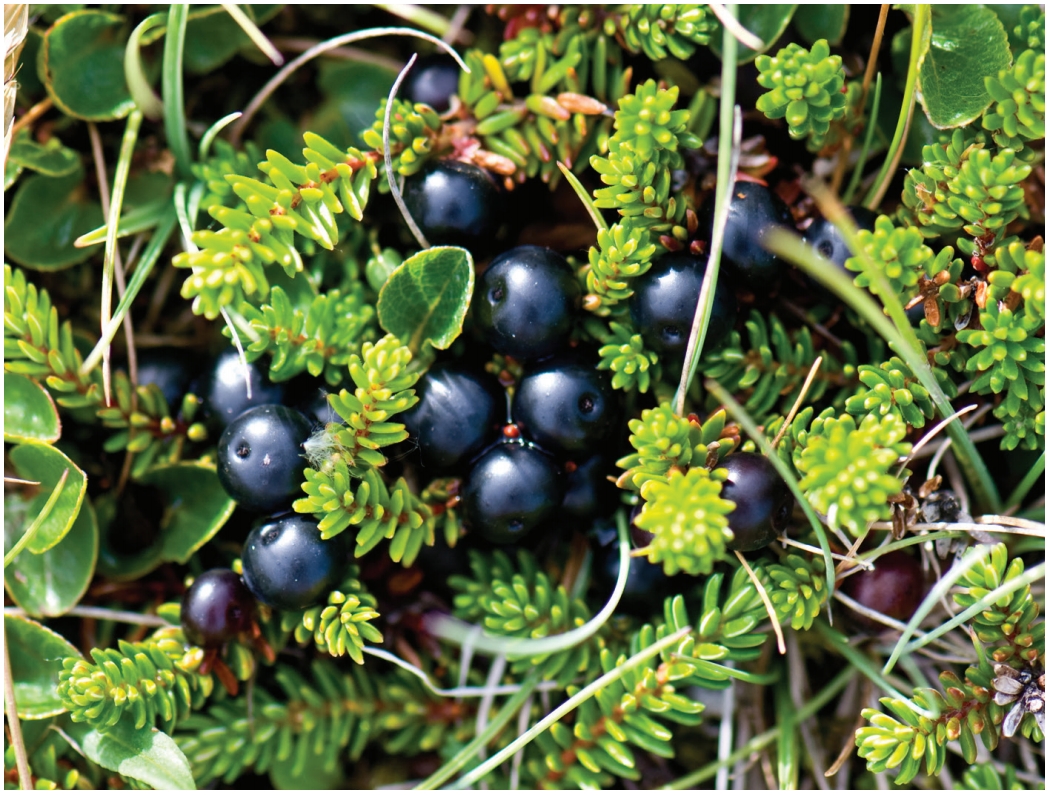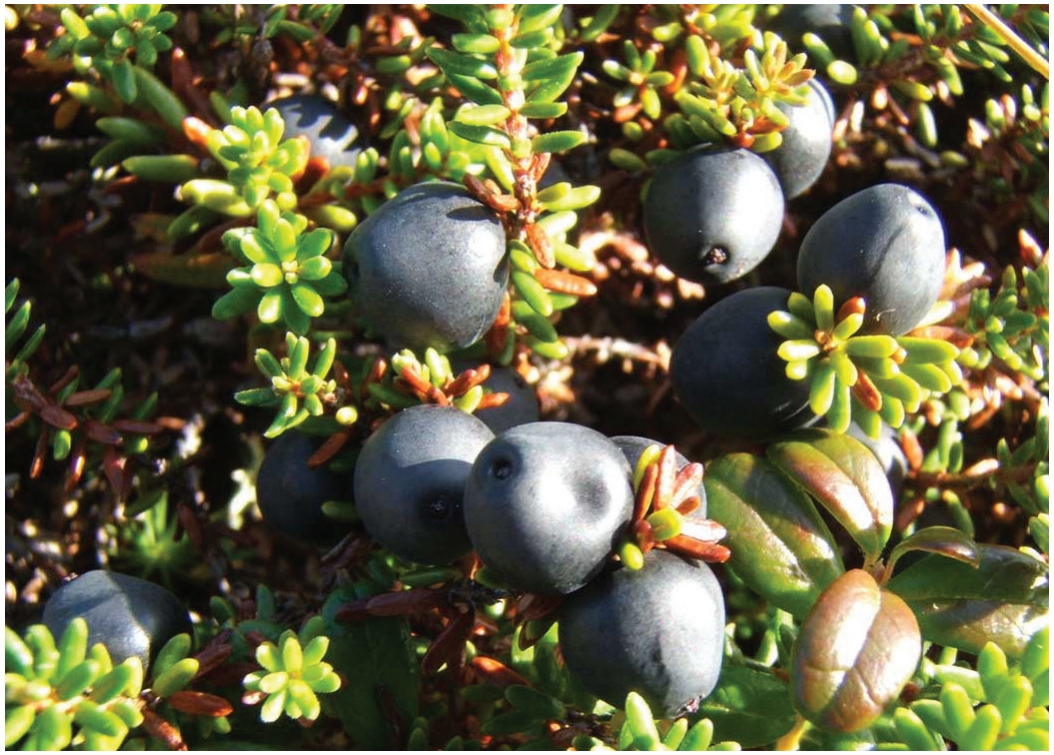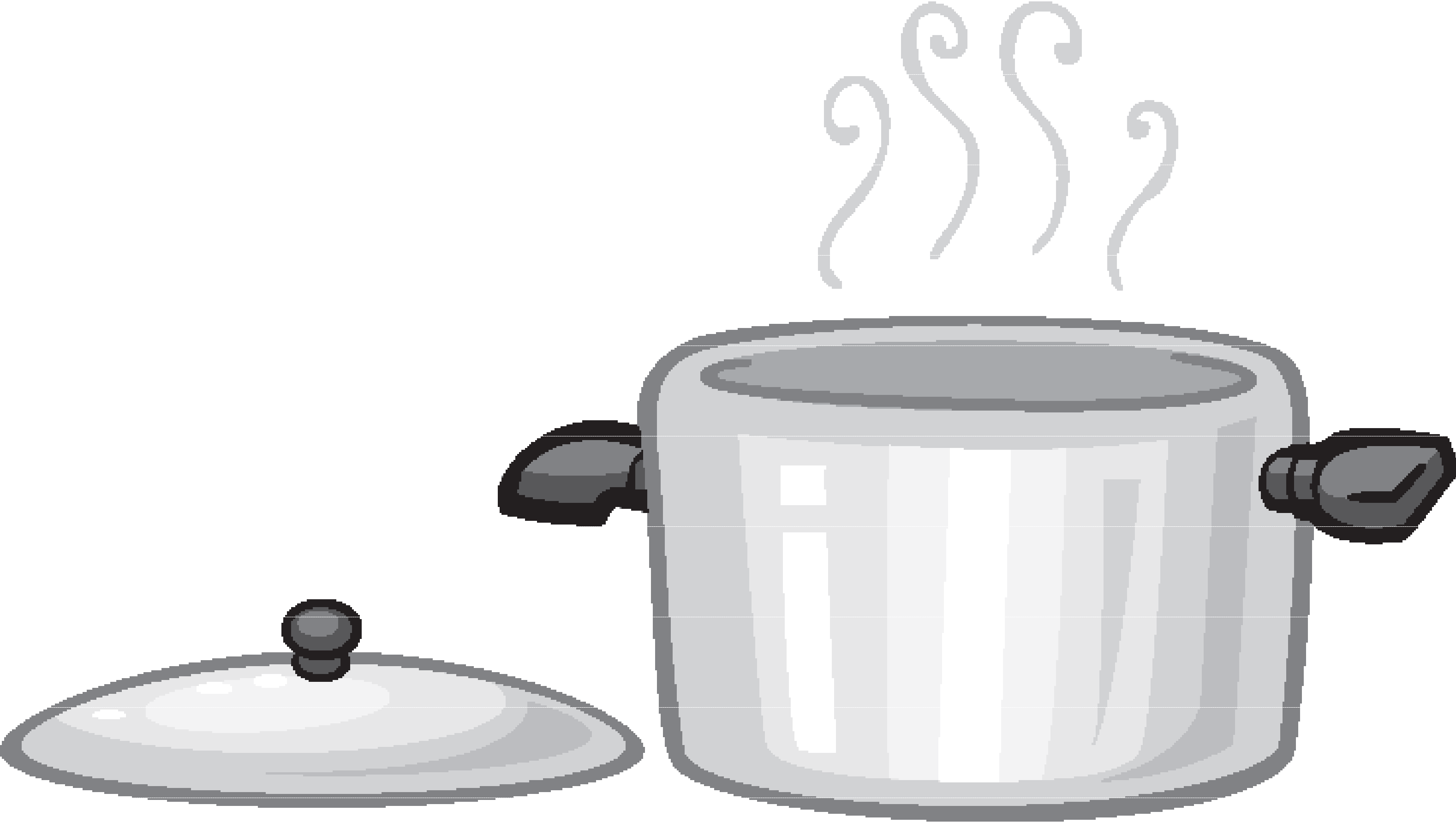Crowberries
FNH-00117 View this publication in PDF form to print or download.
Crowberry (Empetrum nigrum) is also known in English as blackberry or mossberry. Crowberry bushes are small, evergreen shrubs that grow very close to the ground. Their leaves are small, green and needle-like. The flowers are lavender in color. The round berries are blue/black in color and measure 0.15 to 0.40 inches. Crowberries are found in most parts of Alaska. Pick crowberries in the fall, gathering larger berries and leaving the smaller ones to ripen. Berries that overwinter can be collected in the spring. Crowberries become sweeter after the first freeze, but they are softer and burst more easily when picked. If you decide to pick before the first freeze, you can freeze the berries and this will increase their sweetness. Cooking also increases the sweetness and flavor, making this berry a wonderful ingredient in juices, jellies and pies.
Nutrition and Health

Crowberries are a favorite treat, especially in the northern parts of Alaska. Although they have been an important part of Alaska Native diets for centuries, crowberries are gaining in popularity as people realize their high nutritional value. Crowberries are often mixed with blueberries for jam, pie and akutuq, which is a traditional ice cream-like dessert.
Crowberries are an excellent source of fiber and antioxidants. Antioxidants are biochemicals important to the healthy functioning of the body. The oxygen radical absorption capacity test (ORAC) is the main way researchers measure antioxidants in foods. Crowberries have a higher ORAC score than most blueberries found in Alaska. Crowberries have an ORAC score of 94, and a score over 40 is considered very high. A Norwegian study showed that the antioxidants are present, yet reduced, in products such as juice, jelly and wine.
Storage and Preservation
How to Clean and Store
To clean crowberries, spread a clean, dry terry cloth towel over a slanted surface, such as a cutting board with one end propped up a few inches above the other. Gently roll the berries down the towel; most of the debris and leaves will cling to the towel, while the berries roll off. Crowberries should be stored covered in the refrigerator and will keep up to one week.
How to Freeze
Arrange dry, fresh crowberries in one layer on a cookie sheet and place the cookie sheet in the freezer. When frozen, transfer the berries to freezer containers and mark with the date and contents. Properly frozen, crowberries will keep their quality up to two years.
How to Dry
Crowberries have many small seeds and a tough skin, which makes them less suitable for drying.
How to Extract Juice
Combine 8 cups of crowberries and 1 cup water. Crush berries. Bring to a boil and simmer 10 minutes. Strain through a jelly bag or several layers of cheesecloth in a colander. Let the juice drip into a bowl. For clear juice, do not twist or press the jelly bag or cheesecloth. For long-term storage, the juice should be frozen or canned.
Yield: 4 cups
Hot Pack Canning for Juice
Heat juice, stirring occasionally, until it begins to boil. Pour into hot jars, leaving ¼ inch headspace. Wipe jar rims. Adjust lids. Process in a boiling water canner.
- Sterilized pints or quarts: 5 minutes
- Half gallons: 10 minutes
How to Prepare Puree
Cooked method: Add 1 cup of water to 4 cups of crowberries. Cook until skins have popped. Press through a food mill or strainer. Discard skins and seeds.
Yield: 2 cups
Uncooked method: Rinse 4 cups of crowberries, drain, put in a blender and blend until the consistency of a thick puree.
Yield: 2 cups
To freeze: Pack into rigid containers leaving ½ inch headspace for expansion. Seal, mark with the date and contents, and freeze.
To can: Fill hot jars with hot puree, leaving ¼ inch headspace. Process quarts or pints in a boiling water bath for 15 minutes. Purees also can be processed in a dial gauge pressure canner for 8 minutes at 6 pounds pressure or at 5 pounds pressure in a weighted gauge canner. For more information on pressure canning, contact your local Cooperative Extension Service office.
- To sterilize canning jars, boil in water for 5 minutes.
- To prepare two-piece lids (rings and tops), wash, rinse set aside until ready to use. Follow manufacturer’s directions for use.
- If less sugar is desired in recipes calling for pectin, be sure to use no-sugar-needed pectin and follow the instructions on the box.
- See later instructions on this page for how to use a boiling water canner.
Recipes

Crowberry Syrup
- 1 cup crowberry juice
- 2 cups sugar
- 1 teaspoon lemon juice
Combine ingredients in saucepan; heat to 160 degrees F. Use a candy thermometer; do not boil. The syrup is ready to use over waffles, pancakes, hot biscuits, ice cream and other desserts. Syrup will keep up to six months in the refrigerator without crystalizing.
For long-term storage: Sterilize pint or half-pint canning jars and wash and dry lids; immediately pour hot syrup into hot canning jars, leaving ¼ inch headspace. Wipe jar rims and add two-piece lids. Process 5 minutes in a boiling water bath.
Yield: 2 cups
Crowberry Orange Jelly
- 2 cups crowberry juice
- 1½ cups orange juice
- 1 package powdered pectin (1¾ ounce)
- 4½ cups sugar
Sterilize pint or half-pint canning jars and wash and dry lids. Measure sugar and set aside. Measure prepared crowberry juice and orange juice into a large saucepan. Add the pectin and stir until dissolved. Bring to a rolling boil that cannot be stirred down. Add sugar all at once.
Stir constantly as it again comes to a rolling boil and boil hard for 1 minute. Remove from heat and quickly skim off foam. Immediately pour jelly into hot canning jars, leaving ¼ inch headspace. Wipe jar rims and add two-piece lids. Process 5 minutes in a boiling water bath.
Yield: 5 cups
Crowberry Freezer Jelly
- 3 cups crowberry juice
- 4½ cups sugar
- 1 package powdered pectin (1¾ ounce)
- ½ cup water
- 2 tablespoons lemon juice
Combine the sugar and 1¼ cups crowberry juice; stir thoroughly and set aside.
Slowly mix the powdered pectin into the water; heat almost to boiling, stirring constantly. Pour the pectin mixture into the remaining 1¾ cups berry juice; add the lemon juice. Stir until the pectin is completely dissolved. Let pectin mixture stand 15 minutes. Stir occasionally.
Add juice and sugar mixture to the pectin mixture. Stir until all the sugar is dissolved. Pour jelly into freezer containers. Cover with tight lids. Let stand at room temperature until set, which will be from 6 hours to overnight. Label containers with date and contents, and freeze. Refrigerate after opening. If not frozen, keep refrigerated and use within 6 weeks.
Yield: 8 cups
- Fill the canner halfway with water. Preheat water to a low boil. Place filled jars, fitted with lids, into the canner on the rack. Add more boiling water, if needed, so the water level is at least 1 inch above jar tops. Turn heat to its highest position until water boils vigorously. When the water boils, set a timer for the recommended processing time indicated in the recipe. Cover with the canner lid and lower heat setting to maintain a gentle boil throughout the processing time. Add more boiling water, if needed, to keep the water level above the jars.
- When the jars have been boiled for the recommended time, turn off the heat and remove the canner lid. Using a jar lifter, remove the jars and place them on a towel, leaving at least 1 inch of space between the jars during cooling.
- After cooling jars for 12 to 24 hours, remove the screw bands and test seals. Press the middle of the lid with a finger. If the lid springs up when finger is released, the lid is unsealed. If a lid fails to seal on a jar, remove the lid and check the jar-sealing surface for tiny nicks. If necessary, change the jar, add a new, properly prepared lid and reprocess within 24 hours using the same processing time. Alternately, adjust headspace to 1½ inches and freeze or store in the refrigerator and use within three days.
- If lids are tightly sealed on cooled jars, remove screw bands, wash the lid and jar
to remove food residue, then rinse and dry jars. Label and date the jars. Store
in a clean, cool, dark, dry place.

Easy Crowberry Pie
- Pastry for single-crust, 9-inch pie (baked)
- 4 cups fresh crowberries, divided
- 1 cup sugar
- 1 tablespoon lemon juice
- 3 tablespoons cornstarch
- ¼ teaspoon salt
- ¼ cup water
- 1 tablespoon butter
Line the cooled pie shell with 2 cups of the crowberries. Combine the remaining 2 cups of berries with the sugar, lemon juice, cornstarch, salt and water in a saucepan; cook over medium heat until the mixture is medium thick. Remove from the heat. Add butter and cool. Pour over berries in the shell. Chill until served. Serve with whipped cream.
Yield: 6-8 servings
Baked Crowberry Pie
- Pastry for double-crust, 9-inch pie (unbaked)
- 4 cups crowberries
- 2 tablespoons lemon juice
- 1 cup granulated sugar
- ¹⁄3 cup flour
- ¹⁄8 teaspoon ground cloves
Line pie pan with pie crust. In a large mixing bowl, combine crowberries, lemon juice, sugar, flour and cloves; mix well and pour into unbaked pie shell. Dampen edge of shell with water. Add top crust; seal and flute edges. Cut vents in top. Bake at 425 degrees F for 10 minutes. Reduce heat to 375 degrees F and bake for 30 minutes, or until golden brown. Remove from oven and cool on rack.
Yield: 6-8 servings
UAF Cooperative Extension Service Resources
Jams and Jellies, FNH-00730
Canning Overview, FHN-00705
Using Alaska’s Wild Berries and Other Wild Edibles ($15), FNH-00120
Fruit Leather, FNH-00228
Other resources
Holloway, P., R. Dinstel and R. Leiner. 2006. Antioxidants in Alaska Wild Berries. Georgeson Botanical Notes No. 27.
Rothe, G., T. Vasskog, I. Martinussen and K. Rapp. 2004. Picking and Product Development of Crowberry. Norwegian Crop Research Institute.
Jones, A. 1983. Nauriat Niginaqtuat, Plants That We Eat. Maniilaq Association.
Sarah R-P. Lewis, Extension Faculty, Health, Home and Family Development. Originally written by Kari van Delden, former Extension Faculty, Health, Home and Family Development.
Revised November 2021
